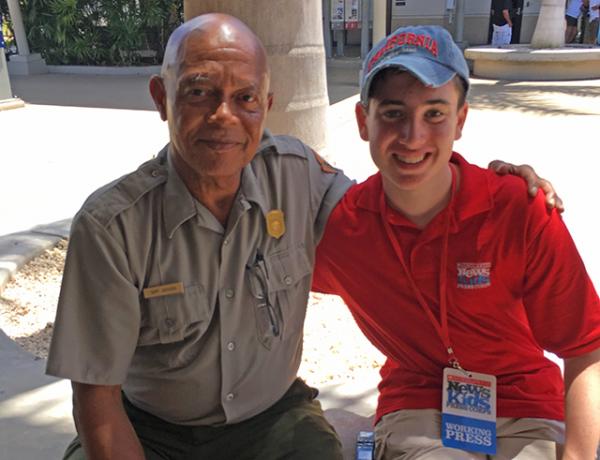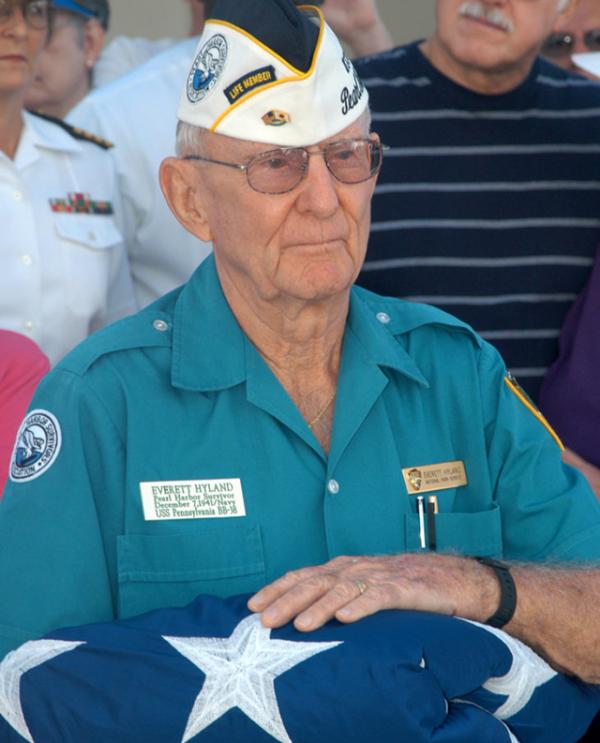KID REPORTERS’ NOTEBOOK
Remembering the Attack on Pearl Harbor


Ethan with Ranger Gary Jackson at the Pearl Harbor Visitor Center. (Photo courtesy of the author)
Throughout history, very few occurrences have had an instant impact on millions of people around the globe. The tragic attack on Pearl Harbor is one of them.
On December 7, 1941, hundreds of Japanese fighter planes launched a surprise attack on the American naval base near Honolulu, Hawaii. Thousands of people were killed, and more than a dozen United States naval ships were damaged or destroyed.
The unexpected attack on Pearl Harbor led the U.S. into World War II, which significantly altered the course of the war. Nearly four years later, the U.S. and their allies declared victory over the Japanese.
Today, people from all over the world visit the historic site, which is operated by the National Park Service. To ensure that the attack will not be forgotten by future generations, Park Service rangers, monuments, and exhibits inform visitors about the events of December 7 and the physical and emotional toll they took. Survivors also talk with visitors.
LEARNING FROM THE PAST
National Park Service Ranger Gary Jackson explained what he most wanted people to know about Pearl Harbor. “It’s not just a memorial,” Jackson said, “but also a national cemetery site, primarily because there were people from the north, south, east, and west of America, so there’s a full representation of the country there.”
Jackson added that it’s important for kids to be educated about Pearl Harbor. “Without our past, our future is clouded,” he said. “We can learn from the mistakes that were made by the generations that came before, to avoid making those same mistakes over and over again.”
While it is fascinating to visit the grounds and the memorial, Jackson said that the best opportunity to truly understand the events as they occurred is to meet a survivor. If visitors forget the buildings or what Pearl Harbor looked like, an encounter with a survivor of the attack will leave a lifelong impression.

Former sailor Everett Hyland is honored at a ceremony at Pearl Harbor in March 2017. Hyland, who was badly injured in the 1941 attack, has served as a volunteer at the Visitor Center for more than two decades. (Photo courtesy of the National Park Service)
SURVIVORS SPEAK OUT
One of the few remaining Pearl Harbor survivors, Everett Hyland, was a sailor on a ship called the USS Pennsylvania. On the day of the attack, Hyland, who is now 94, was wounded when fighters flying overhead bombed the harbor, hitting the Pennsylvania. The attack left Hyland’s left leg badly injured due to the impact of shrapnel. He also suffered the loss of part of his left elbow and biceps.
When his health is cooperating, Hyland loves to visit the Pearl Harbor memorial. He sits in his dedicated chair near the entrance, shakes visitors’ hands, and retells his own story. His goal is to ensure that everyone remembers the more than 2,400 servicemen who perished during the attack. A historical figure in his own right, Hyland plans to continue visiting the site and keep its memory alive for as long as he can.
